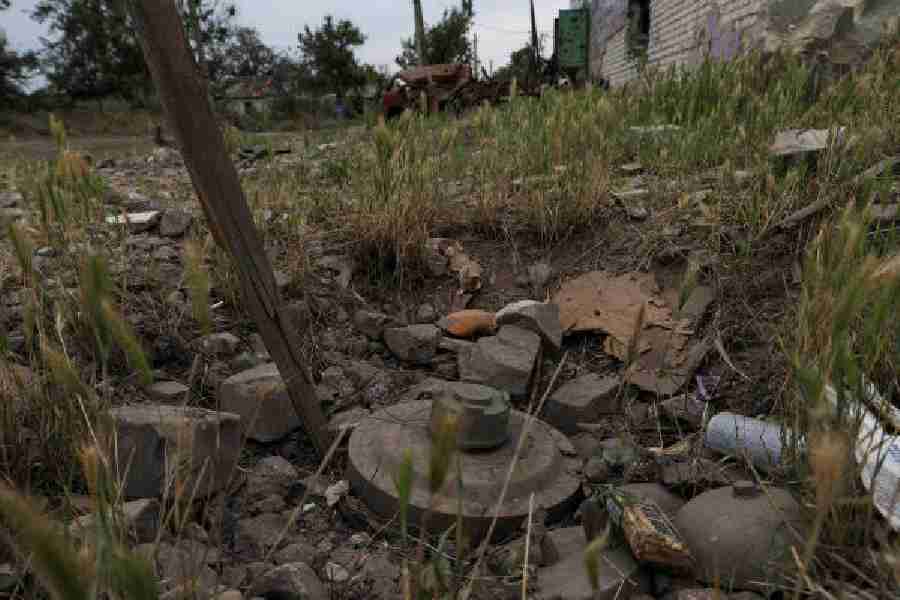It was a grisly scene of bloody limbs and crumpled vehicles as a series of Russian mines exploded across a field in southern Ukraine.
One Ukrainian soldier stepped on a mine and tumbled onto the grass in the buffer zone between the two armies. Nearby lay other Ukrainian troops, their legs in tourniquets, waiting for medical evacuation, according to videos posted online and the accounts of several soldiers involved.
Soon, an armoured vehicle arrived to rescue them. A medic jumped out to treat the wounded and knelt on ground he deemed safe — only to trigger another mine with his knee.
Five weeks into a counter offensive that even Ukrainian officials say is off to a halting start, interviews with commanders and soldiers fighting along the front indicate the slow progress comes down to one major problem: land mines.
The fields Ukrainian forces must cross are littered with dozens of types of mines — made of plastic and metal, shaped like tins of chewing tobacco or soda cans, and with colourful names like “the witch” and “the leaf”.
Ukraine’s army is also hindered by a lack of air support and the deep network of defensive structures the Russians have built. But it is the vast array of mines, trip wires, booby traps and improvised explosive devices that has Ukrainian forces bogged down only a few miles from where they started.
“I couldn’t imagine something like this,” said a Ukrainian private named Serhiy, part of a unit that rescued the soldiers wounded by the explosions. “I thought mines would be lain in lines. But whole fields are filled with them, everywhere.”
Mines have long been a staple of Russian warfare, used extensively in Afghanistan and Chechnya and earlier phases of the fighting in Ukraine, stretching back to 2014. But the minefields in southern Ukraine are vast and complex, beyond what had been previously known, soldiers who have entered them say.
“To clear mines, you should have a lot of motivation and a cool head,” said Maj. Maksym Prysyazhnyuk, a Ukrainian demining expert who slips into the fields at night ahead of infantry advances.
“It’s such delicate work, like of a surgeon, but at the same time, explosions are going off all around you” from artillery in the battle.
Demining specialists venture out with metal detectors and long, slender probes attached to poles, to gingerly poke at the ground to try to find buried mines without setting them off. “These are our tools — and an icon in the pocket,” said Major Prysyazhnyuk, referring to Orthodox religious images. He was at a medical stabilisation point where soldiers wounded by mines turned up in a steady stream.
The minefields are routinely set with booby traps and so-called anti-handling devices that cause mines to detonate if they are lifted, to thwart demining teams. A common tactic is what Major Prysyazhnyuk called a “trick for idiots” — burying anti-personnel mines in front of a trip wire, to target a soldier who might try to disable the trip wire.
More sophisticated explosives include the so-called jumping mines, which, when stepped on, pop up and spray shrapnel, hitting other soldiers nearby. Russia also uses mines triggered byslender, yellow-coloured trip wires that stretch out adozen or so yards, any of which when disturbed can set off an explosion and a spray of shrapnel.
The demining teams work by clearing a path about two feet wide, allowing the infantry to walk forward. Then, the de-miners work back along the path to expand it by another foot or more, to allow two soldiers to walk shoulder-to-shoulder while carrying a stretcher for soldiers wounded in the fight. Last month, a stretcher bearer carrying a wounded colleague triggered a mine because the path could not be widened quickly enough.
Danger exists even after the paths are cleared. Russian forces often fire rockets that scatter small, hard-to-spot green plastic “leaf” mines, also called butterfly mines, over the cleared area, Major Prysyazhnyuk said.
New York Times News Service










